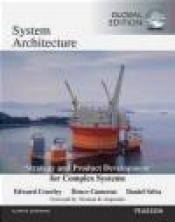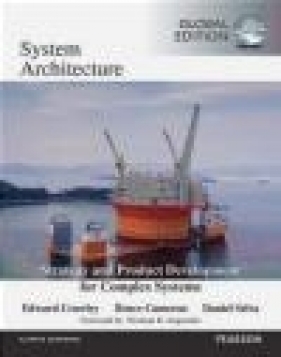330
Książki
Pearson
Systems Architecture
Wydawnictwo:
Pearson
Oprawa: Miękka
Opis
For courses in engineering and technical management Architecture and Function of Complex Systems System architecture is the study of early decision making in complex systems. This text teaches how to capture experience and analysis about early system decisions, and how to choose architectures that meet stakeholder needs, integrate easily, and evolve flexibly. With case studies written by leading practitioners, from hybrid cars to communications networks to aircraft, this text showcases the science and art of system architecture.Foreword Preface Acknowledgments About the Authors PART 1: SYSTEM THINKING 1. Introduction to System Architecture Architecture of Complex Systems The Advantages of Good Architecture Learning Objectives Organization of the Text References 2. System Thinking 2.1 Introduction 2.2 Systems and Emergence 2.3 Task 1: Identify the System, Its Form, and Its Function 2.4 Task 2: Identify Entities of a System, Their Form, and Their Function 2.5 Task 3: Identify the Relationships among the Entities 2.6 Task 4: Emergence 2.7 Summary References 3. Thinking about Complex Systems 3.1 Introduction 3.2 Complexity in Systems 3.3 Decomposition of Systems 3.4 Special Logical Relationships 3.5 Reasoning through Complex Systems 3.6 Architecture Representation Tools: SysML and OPM 3.7 Summary References PART 2: ANALYSIS OF SYSTEM ARCHITECTURE 4. Form 4.1 Introduction 4.2 Form in Architecture 4.3 Analysis of Form in Architecture 4.4 Analysis of Formal Relationships in Architecture 4.5 Formal Context 4.6 Form in Software Systems 4.7 Summary References 5. Function 5.1 Introduction 5.2 Function in Architecture 5.3 Analysis of External Function and Value 5.4 Analysis of Internal Function 5.5 Analysis of Functional Interactions and Functional Architecture 5.6 Secondary Value-Related External and Internal Functions 5.7 Summary References 6. System Architecture 6.1 Introduction 6.2 System Architecture: Form and Function 6.3 Non-idealities, Supporting Layers, and Interfaces in System Architecture 6.4 Operational Behavior 6.5 Reasoning about Architecture Using Representations 6.6 Summary References 7. Solution-Neutral Function and Concepts 7.1 Introduction 7.2 Identifying the Solution-Neutral Function 7.3 Concept 7.4 Integrated Concepts 7.5 Concepts of Operations and Services 7.6 Summary References 8. From Concept to Architecture 8.1 Introduction 8.2 Developing the Level 1 Architecture 8.3 Developing the Level 2 Architecture 8.4 Home Data Network Architecture at Level 8.5 Modularizing the System at Level 8.6 Summary References PART 3: CREATING SYSTEM ARCHITECTURE 9. The Role of the Architect 9.1 Introduction 9.2 Ambiguity and the Role of the Architect 9.3 The Product Development Process 9.4 Summary References 10. Upstream and Downstream Influences on System Architecture 10.1 Introduction 10.2 Upstream Influence: Corporate Strategy 10.3 Upstream Influence: Marketing 10.4 U pstream Influence: Regulation and Pseudo-Regulatory Influences 10.5 Upstream Influence: Technology Infusion 10.6 Downstream Influence: Implementation-Coding, Manufacturing, and Supply Chain Management 10.7 Downstream Influence: Operations 10.8 Downstream Influence: Design for X 10.9 Downstream Influence: Product and System Evolution, and Product Families 10.10 The Product Case: Architecture Business Case Decision (ABCD) 10.11 Summary References 11. Translating Needs into Goals 11.1 Introduction 11.2 Identifying Beneficiaries and Stakeholders 11.3 Characterizing Needs 11.4 Interpreting Needs as Goals 11.5 Prioritizing Goals 11.6 Summary References 12. Applying Creativity to Generating a Concept 12.1 Introduction 12.2 Applying Creativity to Concept 12.3 Develop the Concepts 12.4 Expand the Concepts and Develop the Concept Fragments 12.5 Evolve and Refine the Integrated Concepts 12.6 Select a Few Integrated Concepts for Further Development 12.7 Summary References 13. Decomposition as a Tool for Managing Complexity 13.1 Introduction 13.2 Understanding Complexity 13.3 Managing Complexity 13.4 Summary References PART 4: ARCHITECTURE AS DECISIONS 14. System Architecture as a Decision-Making Process 14.1 Introduction 14.2 Formulating the Apollo Architecture Decision Problem 14.3 Decisions and Decision Support 14.4 Four Main Tasks of Decision Support Systems 14.5 Basic Decision Support Tools 14.6 Decision Support for System Architecture 14.7 Summary References 15. Reasoning about Architectural Tradespaces 15.1 Introduction 15.2 Tradespace Basics 15.3 The Pareto Frontier 15.4 Structure of the Tradespace 15.5 Sensitivity Analysis 15.6 Organizing Architectural Decisions 15.7 Summary References 16. Formulating and Solving System Architecture Optimization Problems 16.1 Introduction 16.2 Formulating a System Architecture Optimization Problem 16.3 NEOSS Example: An Earth Observing Satellite System for NASA 16.4 Patterns in System Architecting Decisions 16.5 Formulating a Large-scale System Architecture Problem 16.6 Solving System Architecture Optimization Problems 16.7 Summary References Appendices Chapter Problems Index
Szczegóły
Rok wydania
2015
Oprawa
Miękka
Ilość stron
480
ISBN
9781292110844
EAN
9781292110844
Kraj produkcji
PL
Producent
GPSR Pearson Central Europe Sp. z o.o.

Dodałeś produkt do koszyka

Systems Architecture
330,00 zł

Recenzje